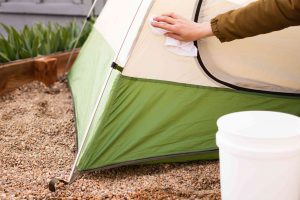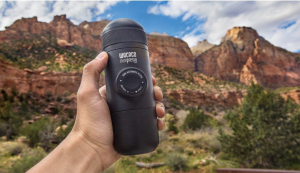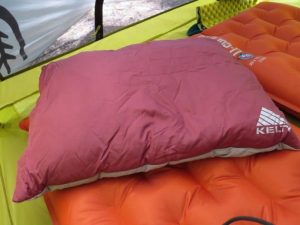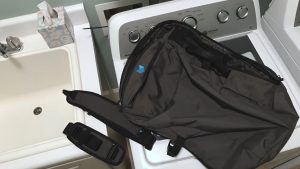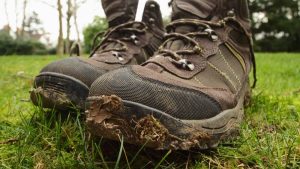A sleeping bag is a necessity when you are traveling or out camping. Keeping it clean is as important as keeping your tent clean. The oil and salt from your body, dust, and grime can accumulate on your sleeping bag and ruin your next trip. This can lead to a shorter lifespan of your sleeping bag, degrades its insulation capability, and weaken the fibers. With the following care and cleaning tips on how to wash a sleeping bag, you can keep your sleeping bag clean and ready to be used on your next tour.
A cleaner sleeping bag on the other hand will increase its durability, effectiveness, make it less smelly, and your sleeping experience will be elevated. Both, sleeping bags and synthetic bags can be cleaned through the following methods. Washing the bags, cleaning, and storing, everything you need to know is here.

Table of Contents
How often should I wash my sleeping bag?
You should not wait for your sleeping bag to get dirty to the point where restoring it would be very difficult and your favorite bag is degraded to the point of no use. Do not let the grime, dust, and oils settle in on the portions of your sleeping bag. It starts from the neck and the hood area, but the important portion is the one hidden, yes, that’s the inside of the sleeping bag.
Wash your sleeping bag at least once a year minimum at the end of the season. If you travel more often, you need to wash it after returning from every trip. It’s best to wash your sleeping bag before packing and storing it away. Body oils, dust, and other greasy stuff stay on the surface of the bag before storing.
If you don’t want to do the laundry and keep the quality of your sleeping bag, you can use a synthetic cleaning product called a liner. The products contain special formulas that keep your bag cleaner for long-term use.
General Cleaning Tips:
- You can easily keep your sleeping bag clean while camping. Use a bag liner to prevent dirt accumulation, sleep in cleaner clothes, and properly air your bag when it gets damper.
- Also, don’t dry-clean your bag, the industrial solvents are not easy on the material of the sleeping bag.
Materials Required for cleaning
How To Machine Wash a Sleeping Bag
- Sleeping bags can be washed in the machine, at least a front-loading washer or top-loading washing machine is required. Some of the home front-loaders are sometimes small, which may not allow your sleeping bag enough space to move and clean freely.
- Open all zippers before putting them in the machine. Keep the water temperature up to 40-degree Celsius or 100-degree Fahrenheit and add an extra rinse cycle. Spin cycles should be set to longer and faster spin. Use a suitable soap and avoid overusing it. Try to add some damp clothes, t-shirts, or a towel to counter-balance the spin.
- Rinse twice your sleeping bag to properly remove the soap, or rewash it in soap-free water.
How to Wash a Down Sleeping Bag
Before washing a down sleeping bag, the wash will take a very few steps, also read the bag maker’s label before starting washing. You need to be patient because the process can take up to 5 hours.
A down sleeping bag, if you pick up the bag after washing, the weight of the water may tear down the internals or the down may shift from one portion to another. The insulation may get torn from the stitching and leaves the bag vulnerable to the environment. So, avoid picking up the sleeping bag that is full of water.
A larger capacity machine ensures the bag is washed thoroughly and completely. You can also hand-wash your down sleeping bag if you don’t have a top-loading washer at home.
Especially for down sleeping bags, use a gear wash. The gear wash is specially developed for the down, like Nikwax Down Wash Direct, or the one that mentions it is safe for down sleeping bags. A regular laundry detergent may lead to clunking.
Open up the zippers to avoid the slider breaking. After washing with the soap, rinse it with clean water two times to remove the extra soap completely. Make sure no residue is left behind and the bag is clean of soap. Completely dry the sleeping bag and do not leave any moisture. If you feel the bag is a dump, rinse it again.
Pick the bag entirely when removing the water from it. Do not pick it up from one or two pints, or it may lead to wear and tear. Gently squeeze out the extra water got to the drying process.
How to Wash a Synthetic Sleeping Bag
First of all, read the bag maker’s instructions. A front-loading commercial washer at a laundromat or wash at home in a machine or by hand. Use a more spacious machine, which means thorough and total cleaning. Try not to wash in a top-loading washer, as your bag may get damaged or get wrapped around the inside.
For a synthetic sleeping bag, our recommendation is to use Nikwax’s Tech-Wash. The local or standard detergent may create clumps or it may create a hydrophobic layer on the sleeping bag material. Unzipping the bag will allow the slider to break while washing. Read instructions and use warm water. The nylon/synthetic bag should feel damp or wet but not soaked.
Lift the sleeping bag completely not from one or two points when removing it from the washer. This way the pressure is equally distributed, and the bag doesn’t strain or rip. The next step is then to dry the bag.
How to Hand-Wash a Sleeping Bag
You can easily wash your sleeping bag by hand at home if you don’t have access to a front-loading washing machine. It will take longer if you wash with hands, but some people find this process gentler and feel it’s easier on their sleeping bags. You will also have to dry the bag on a flat surface and put it in the open to dry out completely before storing it.
Materials Needed:
- A large-sized bathtub and special down soap.
- You can use these washers Granger Down Wash, Gear Aid ReviveX Down Wash, or Nikwax Down Wash.
Now follow the following steps:
- The first step in washing your sleeping bag with your hand is to fill the bathtub with lukewarm water. Mix the down soap in the water, now turn your sleeping bag inside out, and close all the zippers.
- Don’t use bleach, any fabric softener, or any regular detergent as it will lead to degeneration of the external layers of the bag. Do not use too much soap, as it will be difficult to remove excess soap.
- Put your sleeping bag into the tub and start massaging it gently. Make sure the down soap reaches all the seams.
- After massaging, leave it there soaked for one to two hours.
- Now remove the soapy water and pour fresh clean water into the tub and gently remove the soap out. Try not to squeeze or twist the bag. You may need to repeat the process multiple times in order to remove all the soap.
- After that, place your sleeping bag outside under sunlight or shade, on a clean surface such as grass. You can also put it in a front-loading dryer if you got one at home.
- Once the bag is dry, you need to gently fluff up your sleeping bag like a feathered pillow.
- The last thing is to store or hang your dry sleeping bag in uncompressed form. Avoid folding it, this will put a strain on the bag.
How to Dry Your Sleeping Bag
Drying your sleeping bag is as important as washing it. After returning from the trip, you can choose to wash your sleeping or just simply put it to dry without washing it (if the bag is not that dirty). A damp or wet sleeping bag can enhance the growth of mold, mildew, and fungus. Which in turn damages, reduces the lifespan of your sleeping bag.
If you have washed your sleeping bag, you have to completely dry it before storing it. This way it will stay fresh.
Follow the following steps to make sure you have done it right:
- Dryer: To dry your sleeping bag, you need a commercial-sized dryer, as your sleeping bag has enough space to tumble freely. You can also put it in a dryer at home if it fits. Avoid using high temperatures as it will damage the nylon or synthetic material of the bag.
- Tennis Balls: Put two to three tennis balls or cloth towels in the dryer along with the sleeping bag. This method is effective in restore the original loft. It speeds up the drying process. You can apply this method for both synthetic and down sleeping bags.
- Time: Allow as many cycles possible in the dryer to make sure the bag is completely dry. We recommend at least 2 hours in the dryer.
- Open area drying: You can put your sleeping bag in the open to air dry. Though it will take longer. Lay it on a clean surface or grass, do not put it in direct sunlight as the UV rays may destroy the outer protective layers of the bag. If you want to hang it, try to distribute the weight equally or it will put a strain on the bag which may result in wear and tear.
How to Stuff and Store a Sleeping Bag
Storing your bag in a humid and moderate temperature location will keep the quality of the bag as original and restore its warmth. Do not select a damp spot, basements, garages, and attics. The temperature must not be too high or low. A closet might be a good option as the temperature is moderate and not much humid.
Find a suitable corner in your closet, put your sleeping bag in a cotton storage bag that sometimes your sleeping bag comes with when you purchase it. The bag is loose so it doesn’t compress the bag. Use a king-size pillowcase if yours didn’t come with a storage bag, or you can buy a cotton or mesh sack too.
General Sleeping Bag Maintenance and Mistakes to avoid
- Wear clean clothes when sleeping in your bag.
- Put some cloth under the sleeping bag (avoid putting it on the dirt).
- Avoid using a regular detergent or soap.
- Avoid washing your sleeping bag in a top-loading washing machine.
- Use a home dryer only if necessary (avoid it in the first place).
- Avoid lifting your wet bag from one or two points.
- Lift the wet sleeping bag completely to avoid strain on the fiber.
- Avoid drying it directly under the sun (UV light damages the layers of the bag).
- Do not roll your bag while storing, lay it flat or put it in a cotton bag.
- Avoid compressing the sleeping bag when storing.
Other Sleeping Bag Care Tips
Durable Water Repellent DWR Restoring
The sleeping bags fabric is treated with special materials called DWR, that repel water and make the material waterproof. After a lot of washing and using the sleeping bag outdoors, the external layer wears off of it. You will notice that water poured onto the surface is not beading up, which means it now requires DWR treatment. You can use the following products for this purpose Nikwax TX. Direct Spray-On or ReviveX Spray-On Water Repellant.
Leaking and holes
The down bags are down proofed with liners and shells that are tightly woven fabric. This tight fabric prevents the down from getting out of the sleeping bag. If some feathers leak or break out of your bag, do not panic as this is a normal thing with some new down sleeping bags. The down takes time to settle the sharp quill scan poke through the fabric. You just have to put the feathers back in and stuff it back together. The holes or leaks might not be that big. So, no worries.
Fabric Tears and Broken Zippers
- If your bag gets some tears or gets punctured when you are out camping, do not panic. For the time being, you can simply sew up the hole or a small tear. Keep a thread and needle with you while out with your gear. After returning home, you can get rid of the temporary stitch and sew it professionally so the hole stops there.
- To prevent the rip from progressing you can also use a patch of adhesive gear-repair tape. It will stop the tear from getting any further and keep in mind that you have to remove the tape’s adhesive when you get home.
- If your bag gets a hole or a pinch, get your first-aid kit and wrap a bandage on the pinch.
- If your bag gets damaged real seriously, you have to seek professional help, and get the quality work done for your favorite sleeping bag.
FAQ’s

How to Wash a Sleeping Bag 2021 Step by Step Guide
A sleeping bag is a necessity when you are traveling or out camping. Keeping it clean is as important as keeping your tent clean. The oil and salt from your body, dust, and grime can accumulate on your sleeping bag and ruin your next trip. This can lead to a shorter lifespan of your sleeping bag, degrades its insulation capability, and weakens the fibers. With the following care and cleaning tips on how to wash a sleeping bag, you can keep your sleeping bag clean and ready to be used on your next tour.
A cleaner sleeping bag on the other hand will increase its durability, effectiveness, make it less smelly, and your sleeping experience will be elevated. Both, sleeping bags and synthetic bags can be cleaned through the following methods. Washing the bags, cleaning, and storing, everything you need to know is here.

How often should I wash my sleeping bag?
You should not wait for your sleeping bag to get dirty to the point where restoring it would be very difficult and your favorite bag is degraded to the point of no use. Do not let the grime, dust, and oils settle in on the portions of your sleeping bag. It starts from the neck and the hood area, but the important portion is the one hidden, yes, that’s the inside of the sleeping bag.
Wash your sleeping bag at least once a year minimum at the end of the season. If you travel more often, you need to wash it after returning from every trip. It’s best to wash your sleeping bag before packing and storing it away. Body oils, dust, and other greasy stuff stay on the surface of the bag before storing.
If you don’t want to do the laundry and keep the quality of your sleeping bag, you can use a synthetic cleaning product called a liner. The products contain special formulas that keep your bag cleaner for long-term use.
General Cleaning Tips:
- You can easily keep your sleeping bag clean while camping. Use a bag liner to prevent dirt accumulation, sleep in cleaner clothes, and properly air your bag when it gets damper.
- Also, don’t dry-clean your bag, the industrial solvents are not easy on the material of the sleeping bag.
Materials Required for cleaning
How To Machine Wash a Sleeping Bag
- Sleeping bags can be washed in the machine, at least a front-loading washer or top-loading washing machine is required. Some of the home front-loaders are sometimes small, which may not allow your sleeping bag enough space to move and clean freely.
- Open all zippers before putting them in the machine. Keep the water temperature up to 40-degree Celsius or 100-degree Fahrenheit and add an extra rinse cycle. Spin cycles should be set to longer and faster spin. Use a suitable soap and avoid overusing it. Try to add some damp clothes, t-shirts, or a towel to counter-balance the spin.
- Rinse twice your sleeping bag to properly remove the soap, or rewash it in soap-free water.
How to Wash a Down Sleeping Bag
Before washing a down sleeping bag, the wash will take a very few steps, also read the bag maker’s label before starting washing. You need to be patient because the process can take up to 5 hours.
A down sleeping bag, if you pick up the bag after washing, the weight of the water may tear down the internals or the down may shift from one portion to another. The insulation may get torn from the stitching and leaves the bag vulnerable to the environment. So, avoid picking up the sleeping bag that is full of water.
A larger capacity machine ensures the bag is washed thoroughly and completely. You can also hand-wash your down sleeping bag if you don’t have a top-loading washer at home.
Especially for down sleeping bags, use a gear wash. The gear wash is specially developed for the down, like Nikwax Down Wash Direct, or the one that mentions it is safe for down sleeping bags. A regular laundry detergent may lead to clunking.
Open up the zippers to avoid the slider breaking. After washing with the soap, rinse it with clean water two times to remove the extra soap completely. Make sure no residue is left behind and the bag is clean of soap. Completely dry the sleeping bag and do not leave any moisture. If you feel the bag is a dump, rinse it again.
Pick the bag entirely when removing the water from it. Do not pick it up from one or two pints, or it may lead to wear and tear. Gently squeeze out the extra water got to the drying process.
How to Wash a Synthetic Sleeping Bag
First of all, read the bag maker’s instructions. A front-loading commercial washer at a laundromat or wash at home in a machine or by hand. Use a more spacious machine, which means thorough and total cleaning. Try not to wash in a top-loading washer, as your bag may get damaged or get wrapped around the inside.
For a synthetic sleeping bag, our recommendation is to use Nikwax’s Tech-Wash. The local or standard detergent may create clumps or it may create a hydrophobic layer on the sleeping bag material. Unzipping the bag will allow the slider to break while washing. Read instructions and use warm water. The nylon/synthetic bag should feel damp or wet but not soaked.
Lift the sleeping bag completely not from one or two points when removing it from the washer. This way the pressure is equally distributed, and the bag doesn’t strain or rip. The next step is then to dry the bag.
How to Hand-Wash a Sleeping Bag
You can easily wash your sleeping bag by hand at home if you don’t have access to a front-loading washing machine. It will take longer if you wash with hands, but some people find this process gentler and feel it’s easier on their sleeping bags. You will also have to dry the bag on a flat surface and put it in the open to dry out completely before storing it.
Materials Needed:
- A large-sized bathtub and special down soap.
- You can use these washers Granger Down Wash, Gear Aid ReviveX Down Wash, or Nikwax Down Wash.
Now follow the following steps:
- The first step in washing your sleeping bag with your hand is to fill the bathtub with lukewarm water. Mix the down soap in the water, now turn your sleeping bag inside out, and close all the zippers.
- Don’t use bleach, any fabric softener, or any regular detergent as it will lead to degeneration of the external layers of the bag. Do not use too much soap, as it will be difficult to remove excess soap.
- Put your sleeping bag into the tub and start massaging it gently. Make sure the down soap reaches all the seams.
- After massaging, leave it there soaked for one to two hours.
- Now remove the soapy water and pour fresh clean water into the tub and gently remove the soap out. Try not to squeeze or twist the bag. You may need to repeat the process multiple times in order to remove all the soap.
- After that, place your sleeping bag outside under sunlight or shade, on a clean surface such as grass. You can also put it in a front-loading dryer if you got one at home.
- Once the bag is dry, you need to gently fluff up your sleeping bag like a feathered pillow.
- The last thing is to store or hang your dry sleeping bag in uncompressed form. Avoid folding it, this will put a strain on the bag.
How to Dry Your Sleeping Bag
Drying your sleeping bag is as important as washing it. After returning from the trip, you can choose to wash your sleeping or just simply put it to dry without washing it (if the bag is not that dirty). A damp or wet sleeping bag can enhance the growth of mold, mildew, and fungus. Which in turn damages, reduces the lifespan of your sleeping bag.
If you have washed your sleeping bag, you have to completely dry it before storing it. This way it will stay fresh.
Follow the following steps to make sure you have done it right:
- Dryer: To dry your sleeping bag, you need a commercial-sized dryer, as your sleeping bag has enough space to tumble freely. You can also put it in a dryer at home if it fits. Avoid using high temperatures as it will damage the nylon or synthetic material of the bag.
- Tennis Balls: Put two to three tennis balls or cloth towels in the dryer along with the sleeping bag. This method is effective in restore the original loft. It speeds up the drying process. You can apply this method for both synthetic and down sleeping bags.
- Time: Allow as many cycles possible in the dryer to make sure the bag is completely dry. We recommend at least 2 hours in the dryer.
- Open area drying: You can put your sleeping bag in the open to air dry. Though it will take longer. Lay it on a clean surface or grass, do not put it in direct sunlight as the UV rays may destroy the outer protective layers of the bag. If you want to hang it, try to distribute the weight equally or it will put a strain on the bag which may result in wear and tear.
How to Stuff and Store a Sleeping Bag
Storing your bag in a humid and moderate temperature location will keep the quality of the bag as original and restore its warmth. Do not select a damp spot, basements, garages, and attics. The temperature must not be too high or low. A closet might be a good option as the temperature is moderate and not much humid.
Find a suitable corner in your closet, put your sleeping bag in a cotton storage bag that sometimes your sleeping bag comes with when you purchase it. The bag is loose so it doesn’t compress the bag. Use a king-size pillowcase if yours didn’t come with a storage bag, or you can buy a cotton or mesh sack too.
General Sleeping Bag Maintenance and Mistakes to avoid
- Wear clean clothes when sleeping in your bag.
- Put some cloth under the sleeping bag (avoid putting it on the dirt).
- Avoid using a regular detergent or soap.
- Avoid washing your sleeping bag in a top-loading washing machine.
- Use a home dryer only if necessary (avoid it in the first place).
- Avoid lifting your wet bag from one or two points.
- Lift the wet sleeping bag completely to avoid strain on the fiber.
- Avoid drying it directly under the sun (UV light damages the layers of the bag).
- Do not roll your bag while storing, lay it flat or put it in a cotton bag.
- Avoid compressing the sleeping bag when storing.
Other Sleeping Bag Care Tips
Durable Water Repellent DWR Restoring
The sleeping bags fabric is treated with special materials called DWR, that repel water and make the material waterproof. After a lot of washing and using the sleeping bag outdoors, the external layer wears off of it. You will notice that water poured onto the surface is not beading up, which means it now requires DWR treatment. You can use the following products for this purpose Nikwax TX. Direct Spray-On or ReviveX Spray-On Water Repellant.
Leaking and holes
The down bags are down proofed with liners and shells that are tightly woven fabric. This tight fabric prevents the down from getting out of the sleeping bag. If some feathers leak or break out of your bag, do not panic as this is a normal thing with some new down sleeping bags. The down takes time to settle the sharp quill scan poke through the fabric. You just have to put the feathers back in and stuff it back together. The holes or leaks might not be that big. So, no worries.
Fabric Tears and Broken Zippers
- If your bag gets some tears or gets punctured when you are out camping, do not panic. For the time being, you can simply sew up the hole or a small tear. Keep a thread and needle with you while out with your gear. After returning home, you can get rid of the temporary stitch and sew it professionally so the hole stops there.
- To prevent the rip from progressing you can also use a patch of adhesive gear-repair tape. It will stop the tear from getting any further and keep in mind that you have to remove the tape’s adhesive when you get home.
- If your bag gets a hole or a pinch, get your first-aid kit and wrap a bandage on the pinch.
- If your bag gets damaged real seriously, you have to seek professional help, and get the quality work done for your favorite sleeping bag.
FAQ’s
Can I put my sleeping bag in the washing machine?
Yes, you can easily machine wash your sleeping bag, you only require to have a front-loading washer. Avoid using a top-loading washer or use it only without an agitator. Wash your sleeping bag at home or visit a laundromat Put the washer on a gentle cycle and use lukewarm water.
What should I wash my sleeping bag with?
Do not use regular detergents or soaps to wash your sleeping bag as it can damage the fabric and you have to put a lot of effort into getting rid of it completely. Use recommended detergents and products only. For both synthetic and down sleeping bags, you can find several products that are gentle on the fabric and you get a cleaner sleeping bag.
Should I wash my sleeping bag zipped or unzipped?
It’s best you unzip your bag, turn It inside out, and then zip it half before washing it. This method will save your sleeping bag from tearing up in the machine if the zip is completely open, also the bag will be completely washed from inside out. Put some tennis balls or towels for the bag to stay stuffed and not lump up.
Can I use a service to clean my sleeping bag?
You can use professional services for your sleeping bags, but it is more convenient to wash them yourself. Washing it yourself will cost you less and you can easily do it again after every trip. We recommend you gather the necessary items and wash them yourself.
How much does it cost to wash a sleeping bag?
Charges in the UK start from 10 pounds and go up, and if your sleeping bag needs repairing, they will charge you more. Different laundromats charge different rates. It also depends on the type of sleeping bag. If you like to have professional care for your sleeping bag you can go for it. Or else you have the option to do it yourself at your own convenience.

